Download PDF
Download page Importing and Using Daymet Precipitation Data.
Importing and Using Daymet Precipitation Data
Introduction
This tutorial demonstrates how Daymet gridded precipitation products produced by the National Aeronautics and Space Administration (NASA) can be obtained, imported, and used within HEC-HMS. This tutorial will also show how simulated runoff changes when different data is used in an existing model of the Black Earth Creek watershed.
Download initial project files here:
Note that files are provided in a compressed folder and must be unzipped.
Downloading Data
Daymet is a data product derived from a collection of algorithms and computer software designed to interpolate and extrapolate from daily meteorological observations to produce gridded estimates of daily weather parameters (NASA, 2021). The gridded Daymet products are used in a wide variety of research projects across North America. Daily precipitation grids are available from 1980 to the present for North America and Hawaii (1950-present for Puerto Rico) and are available at a horizontal resolution of one kilometer. Precipitation is reported in millimeters per day. All Daymet datasets are available in NetCDF format from the following website: https://daymet.ornl.gov/getdata. The Daymet website has several user-friendly tools for downloading gridded data. This tutorial used the Tile Selection Tool, which allows the user to select and download data for a range of years for a 2-degree x 2-degree (222 km x 222 km) region using a map tool. A screenshot of the Tile Selection Tool is shown below.
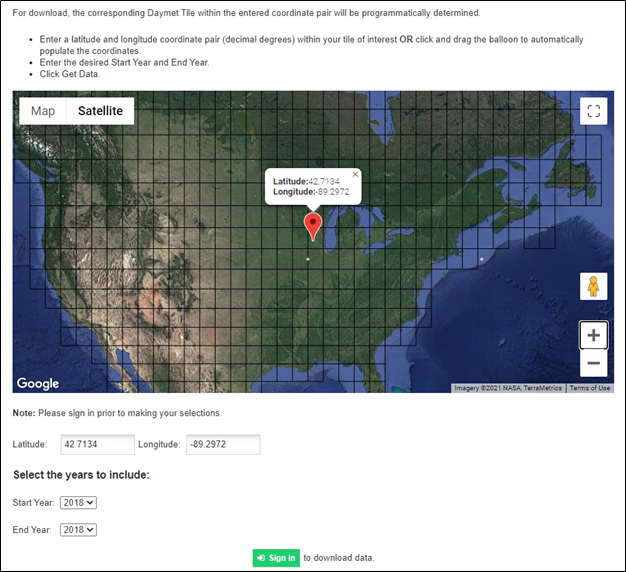
Data was downloaded for a period of years from the Daymet website as a compressed TAR file and then unzipped in a 3-step process. First, the TAR file was unzipped using the 7-Zip File Manager. Then, the TAR.GZ file shown below was unzipped.

Lastly, a final TAR file was unzipped, and a subfolder that contained the gridded Daymet datasets was made available. Grids for day length, precipitation, shortwave radiation, snow water equivalent, maximum air temperature, minimum air temperature, and water vapor pressure were all packaged with the Daymet archive, as shown below.
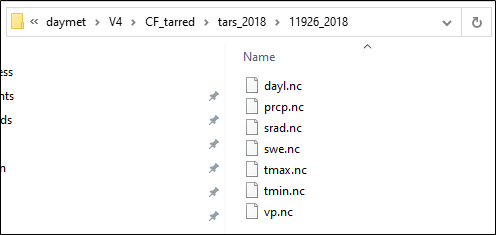
A Note on Data Quality
The quality of gridded data will vary and should be assessed to ensure the information is suitable for the purpose of the model it is being applied to. Factors such as radar beam blockage and the distance from the radar station to the storm can affect the measurement of precipitation data. It is recommended that gridded data be compared to other data sources to determine if it is sufficient for use in a hydrologic model. For example, gridded precipitation can be compared to point gage data to check the magnitude and timing of a rain event. Programs like the HEC Meteorological Visualization Utility Engine (MetVue) make is easy to compare gridded data to point rainfall.
Using the HEC-HMS Gridded Data Import Wizard
HEC-HMS can ingest multiple gridded data formats including NetCDF, HDF, GRIB, ASCII, and others. The Gridded Data Import Wizard in HEC-HMS guides the user through importing raw gridded precipitation data and creates a DSS file which can be used to perform simulations. The “File | Import | Import Gridded Data…” option was selected, as shown below, to launch the Gridded Data Import Wizard.
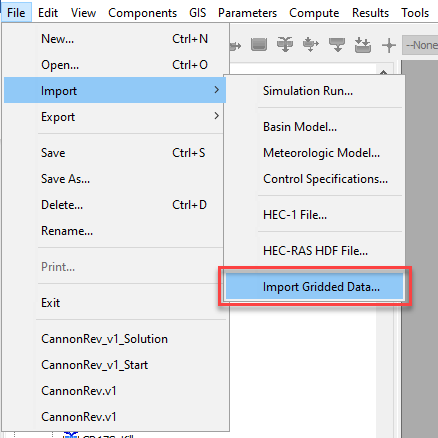
The figure below shows the Gridded Data Import Wizard.
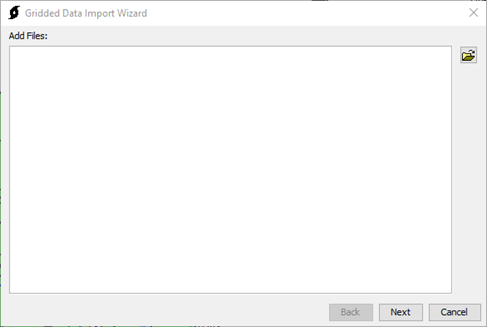
Select Data Files
On the first panel, click the folder icon, navigate to the NetCDF precipitation file (…\daymet\V4\CF_tarred\tars_2018\11926_2018\prcp.nc), select the file, and click “Open” to add the file, as shown below.
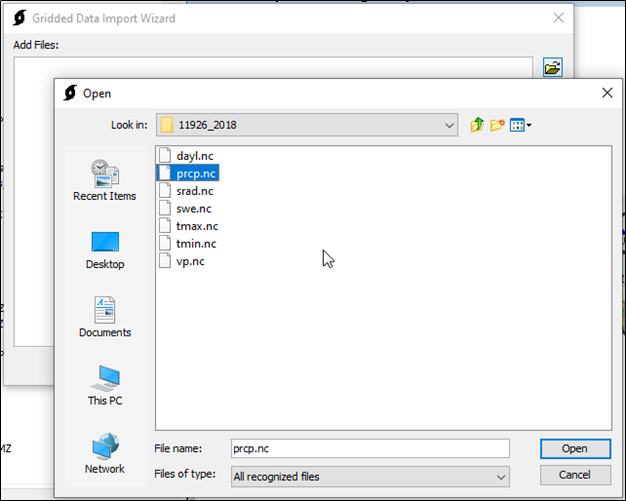
Once the raw NetCDF file is added, click “Next” to confirm the selection of the file, as shown below.
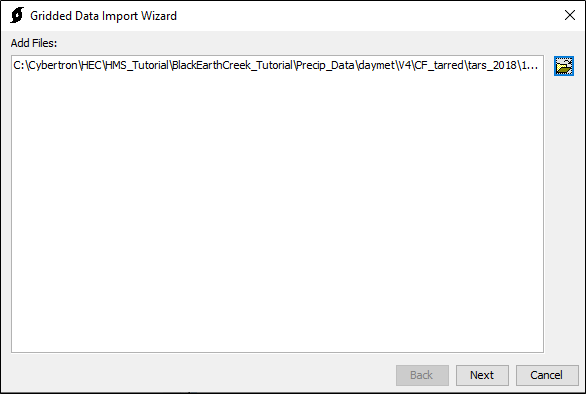
Select Variables to Import
Most scientific data formats have an internal self-describing structure that organizes the data. This includes variables, dates, extents, units, etc. In this example, the variable “prcp”, which represents daily total precipitation, was selected by double clicking (or using the arrow), as shown below. The “Next” button was clicked to finalize the selection.
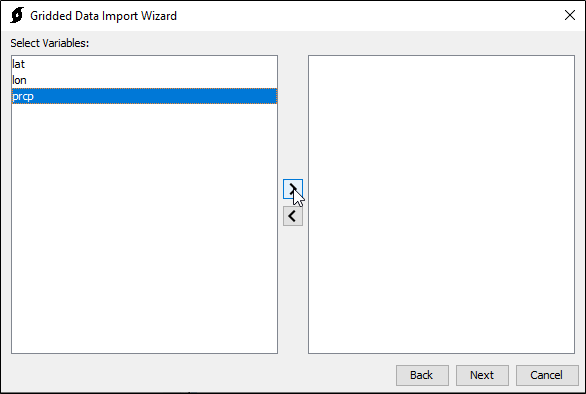
Clipping Extents and Resampling Parameters
The Daymet data covers a 222 kilometer by 222 kilometer area, which is significantly larger than the watershed of interest. To reduce the size of the resultant data set, the raw data was clipped using a shapefile of the watershed. The shapefile used to clip the data source represents the subbasin shapefile from the watershed model.
Alternatively, the clipping shapefile can be created in HEC-HMS by selecting “GIS | Export Georeferenced Elements” and using the subbasin element type. Be sure to buffer any polygon used for clipping by 1 to 2 miles.
The “target wkt” is a coordinate reference system (CRS) in well-known text (WKT) format. The globe button can be used to select a typical CRS. Alternatively, a PRJ projection file from a shapefile can be used. For this tutorial, the CRS of the Standard Hydrologic Grid (SHG) was selected, as shown below. If no projection was selected, the data would retain its original projection.
If the discretization is a file-specified “.mod” file, the gridded boundary conditions have to be the same cell size and projection that was used to generate the “.mod” file. The “.mod” files were commonly used within HEC-HMS models that used gridded data and were developed in versions which pre-date HEC-HMS version 4.7. The “.mod” files in earlier versions of HEC-HMS were typically generated using the Standard Hydrologic Grid (SHG) with a 2,000 meter cell size.
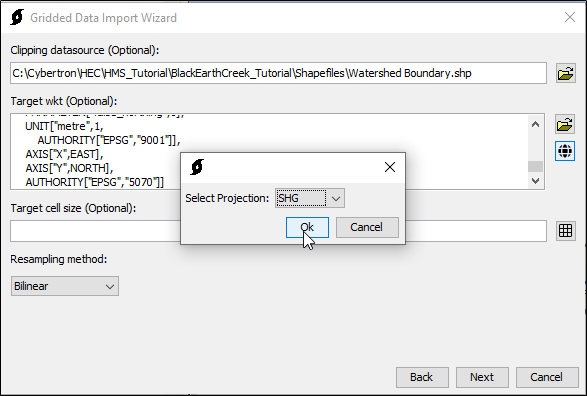
The target cell size is the cell size of the resampled grids. It is recommended the target cell size be similar to the cell size used by the gridded precipitation data. A target cell size of 2,000 meters was selected because this is the cell size associated with the SHG, as shown below. However, a smaller cell size may improve the model results given the small size of the Black Earth Creek watershed (272 km2).
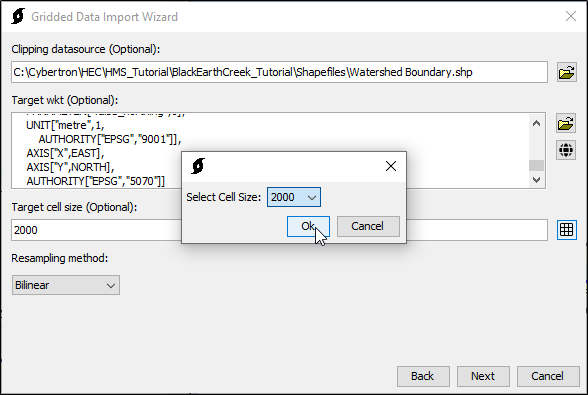
The resampling method is the method used to resample the grid. The Import Wizard allows the user to select between the Nearest Neighbor, Average, and Bilinear method. A description of each method is included below. Select the bilinear resampling method for continuous data like precipitation. Click “Next” once the clipping source, CRS, cell size, and resampling method are selected.
- Nearest Neighbor – A resampling technique for discrete (categorical) data which does not alter the value of the input cells. This sampling technique is used for nominal or ordinal data where each value represents a class, member, or classification. Examples of this type of data include land-use, soil, or forest type (ESRI, 2021).
- Average – The value of the output cell is computed from the values of all input cells which overlap the output cell (ESRI, 2021).
- Bilinear – Bilinear interpolation uses the value of the four nearest input cell centers to determine the value for the output raster cell. The value of the output raster cell is a weighted average of these four values based on their distance from the center of the output cell. This resampling technique is well suited for continuous data or surfaces, like temperature or precipitation (ESRI, 2021).
For HEC-HMS meteorologic models that use gridded boundary conditions, all grids should be resampled to the same CRS, extent, and grid cell size.
Destination HEC-DSS File
The Gridded Data Import Wizard will now import the raw gridded Daymet data and convert it to a DSS file format. The last step is to select a destination of the DSS file that will store the gridded data. Navigate to a directory to store the data, provide a file a name with a “.dss” extension, and click “Open”, as shown below.
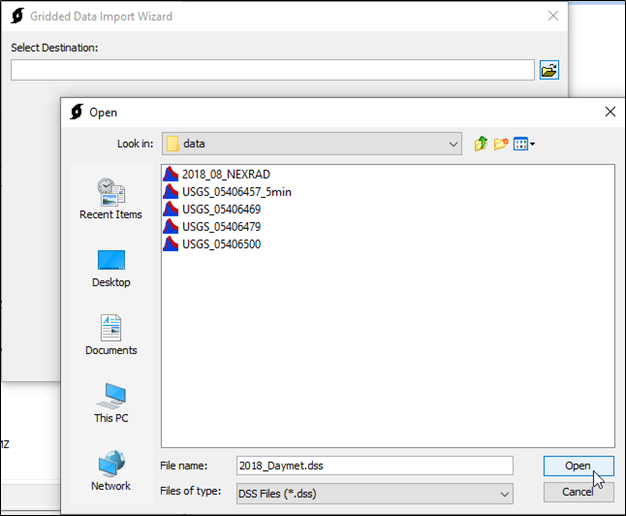
The Gridded Data Import Wizard will now allow the pathnames of the data to be defined. Note that the C, D, and E-Parts of the pathnames use the wildcard asterisk because the program automatically names these parts based on the type and timestep of the data. The user can specify the A, B, and F-Parts which represent the grid type, geographic area, and data source, respectively. An example for this study is shown below for the Black River Creek watershed study area. Click “Next” to run the Import Wizard which creates the DSS file and converts the NetCDF data to DSS format for use in HEC-HMS. The time to complete this process varies depending on the amount of data but typically takes less than one minute.
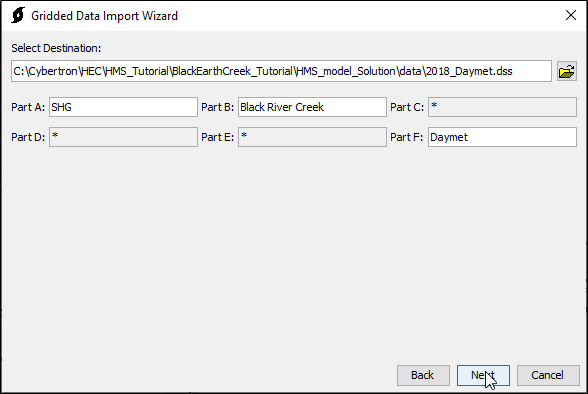
The Gridded Data Wizard will indicate when it has finished importing the data, as shown below. After the import is complete, click “Close” to exit the Gridded Data Import Wizard.
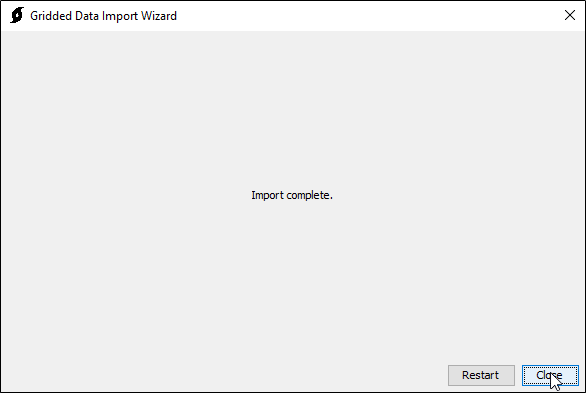
Using Gridded Meteorologic Data within HEC-HMS
This demonstration uses an HEC-HMS model of the Black Earth Creek watershed in south central Wisconsin. The model was originally calibrated using Next Generation Radar (NEXRAD) Multi-sensor Precipitation Estimator (MPE) hourly gridded precipitation data obtained from the National Weather Service North Central River Forecast Center (NCRFC). The new Daymet precipitation grids use a daily timestep and will replace the NCRFC MPE grids. This will illustrate how the results change when different data sources are used in the model. Model parameters are held constant with the exception of the newly imported Daymet precipitation data.
Create New Grid Data Object
A precipitation gridset must be created and linked to the Daymet DSS records. Within HEC-HMS, select “Components | Create Component | Grid Data…” to generate a parameter grid. Provide a recognizable name and a description of what the data represents. The data type should be “Precipitation Gridsets”. Click “Create” to add the new precipitation gridset to the HEC-HMS model, as shown below

Select Previously Created HEC-DSS File and Part Names
The Grid Data Object created in the previous step is now available within the “Grid Data | Precipitation Gridsets” tree in HEC-HMS. Select the “2018_Daymet” grid created in the previous step. The data source should be set to “Single Record HEC-DSS”. The DSS Filename should be the pathname of the “2018_Daymet.dss” file and a single pathname from the DSS file needs to be selected, as shown below. Any pathname within the DSS file can be selected here.
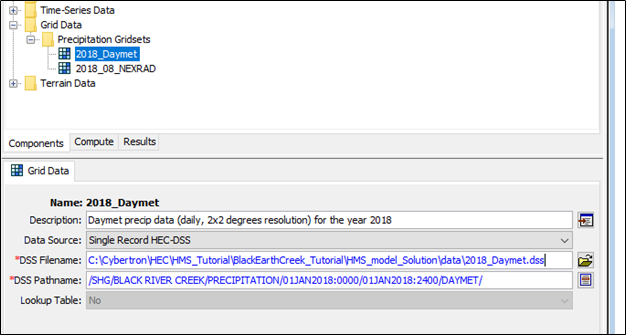
Configure Meteorologic Model
For this example, create a new meteorological model by selecting “Components | Meteorologic Model Manager | New…” Provide a name and description for the new meteorological model. Click “Create” when finished entering a name and description, as shown below.

Select the “2018_08_Daymet” meteorologic model from the Meteorologic Models tree. Select the “Gridded Precipitation” option within the Precipitation drop down menu and set the Replace Missing option to “Set to Default”; this allows the simulation to continue if a timestep with missing data is encountered, as shown below.
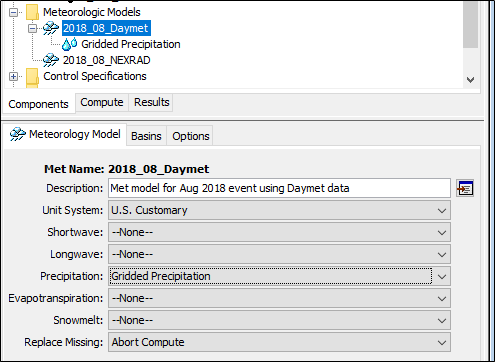
Click the “Basins” tab of the “2018_08_Daymet” Meteorological Model and ensure that the basin model that will be used for a simulation is set to “Yes”. In this case the basin model used is the “BlackEarthCreek_Tutorial” model, as shown below.
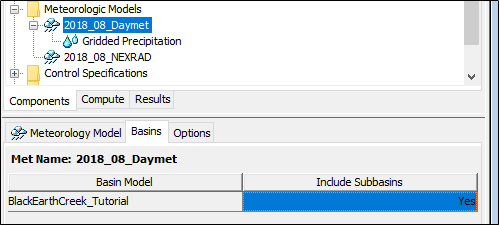
Within the “2018_08_Daymet” Meteorological Model, highlight the “Gridded Precipitation” icon. Select the “2018_Daymet” option within the Grid Name drop down menu, as shown below.
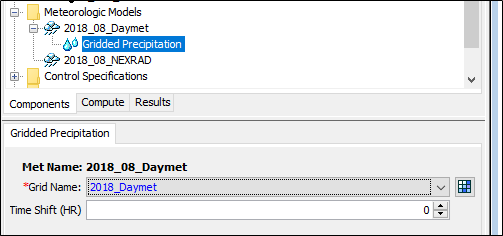
Create a Simulation Run
Set up a simulation run which uses the Daymet data grid, a basin model, a meteorological model, and control specifications. For this exercise, the existing basin model and control specifications will be used rather than creating separate model components. Select “Compute | Create Compute | Simulation Run…” to access the Create a Simulation Run Wizard, as shown below.
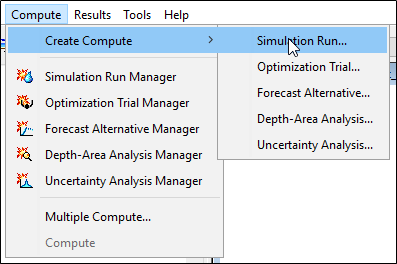
Provide a descriptive name for the simulation run, as shown below. Click “Next”.
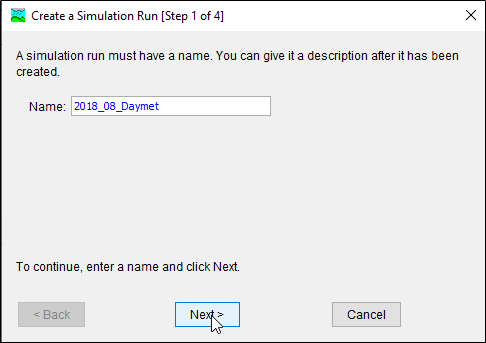
Select a basin model to use with the simulation run. In this case, the calibrated basin model for the 2018 event (“BlackEarthCreek_Tutorial”) is selected for an easy comparison to show how different precipitation sources affect the results, as shown below. Click “Next”.
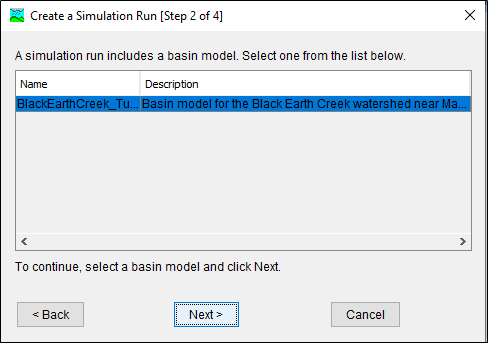
Select the meteorological model which uses the Daymet data, as shown below. Click “Next”.

The final step is to select the control specification. For this case, the existing “2018_08” Control Specifications were used, as shown below. Click “Finish”. The simulation run is now created and ready to use.
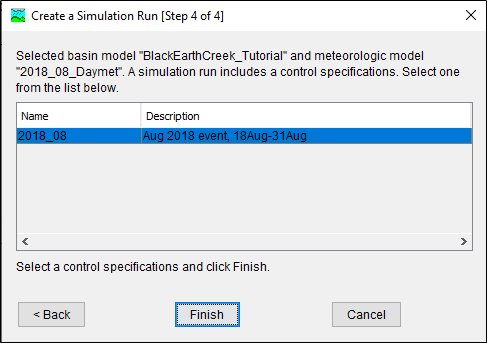
Compute the Simulation
Select the run that was just created from the Simulation Run drop down box. Press the compute button to perform a simulation, as shown below. In this example, the total simulation computed in less than 10 seconds.

Visualize Results
Visualize results by right clicking on an element of interest and selecting “View Results | Graph.” Results from the “2018_08_Daymet” simulation are shown below.
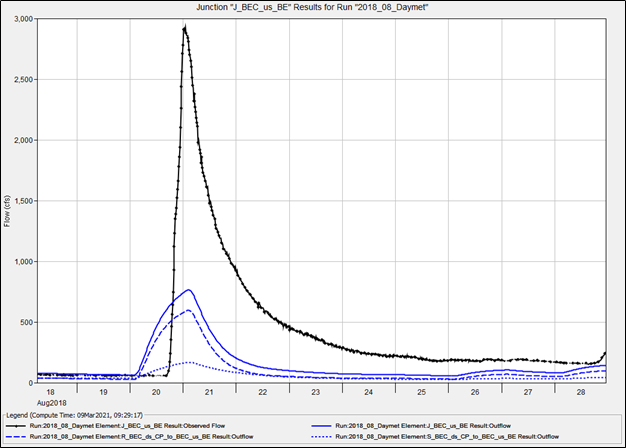
The figure below shows results when using the original NCRFC MPE hourly precipitation data (1-km resolution). All model parameters were held constant and the only difference between the two scenarios is the source of the precipitation data. As the graphs show, there is a considerable difference in peak flow when different data sources are used. In this case, the Daymet data does not adequately capture the rainfall intensity that fell over the Black Earth Creek watershed during the August 20-21 storm event. This is due to the coarse resolution (2 degrees or 222 km2) and the large timestep (24 hours) of the Daymet dataset. The Black Earth Creek watershed is small (272 km2), and summer rainfall events in the basin are generally short (6-9 hours) and localized to a relatively small area. The August 2018 storm lasted about 9 hours, and the epicenter of the event spanned a radius of approximately 10 km. Since the spatial and temporal resolution of the Daymet precipitation data is coarse, results within the watershed in question are lacking in accuracy.
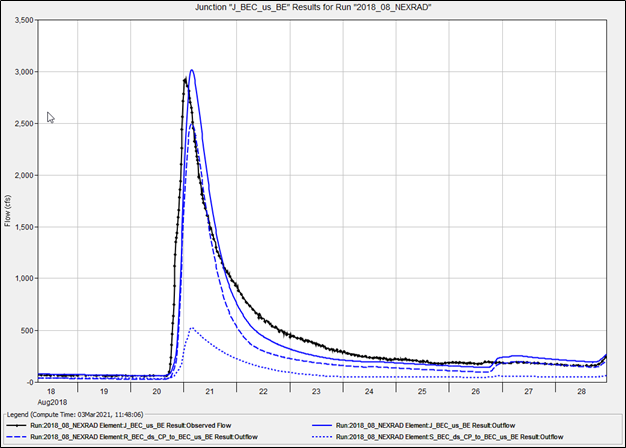
Download final project files here: Final HEC-HMS project
Note that files are provided in a compressed folder and must be unzipped.
Useful Links
NASA – Detailed user guide for Daymet data
ABRFC - Sources of Error in Gridded Precipitation Measurements
References
ESRI. (2021). ArcGIS Desktop. Retrieved from Cell size and resampling in analysis: https://desktop.arcgis.com/en/arcmap/latest/extensions/spatial-analyst/performing-analysis/cell-size-and-resampling-in-analysis.htm
NASA. (2021). Daymet Daily Surface Weather and Climatological Summaries. Retrieved from https://daymet.ornl.gov/